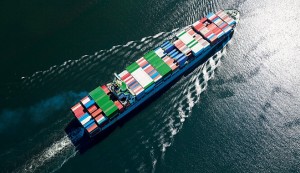Catastrophe risk modelling firm RMS has highlighted the growing catastrophe exposures faced by ports around the world. Analysis from the firm reveals that a combination of cargo type and the type of natural disaster risk are significant drivers of potential losses, and not just the size of container hubs.
 After the devastating and costly Tianjin, China port explosions in the summer of 2015, which is expected to cause insured losses of beyond $3 billion, it’s apparent that insurance, reinsurance firms, and the broader risk transfer landscape, including ILS fund managers, require a greater understanding of the exposure to catastrophe risks of ports around the world.
After the devastating and costly Tianjin, China port explosions in the summer of 2015, which is expected to cause insured losses of beyond $3 billion, it’s apparent that insurance, reinsurance firms, and the broader risk transfer landscape, including ILS fund managers, require a greater understanding of the exposure to catastrophe risks of ports around the world.
In an effort to underline the potential loss for insurance and reinsurance capital, RMS, utilising the RMS Marine Cargo Model, has analysed the catastrophe risk of ports across the globe, ranking the top ten for greatest potential loss.
The analysis calculated a 1-in-500 year loss event for each port, revealing that the Nagoya port in Japan, and the Guangzhou port, China, are the riskiest two ports in the world, with an estimated marine cargo loss of $2.3 billion and $2 billion, respectively.
The Plaquemines port in Los Angeles, U.S. came in third with an estimated marine cargo loss from a 1-in-500 year catastrophe event of $1.5 billion. The Bremerhaven port in Germany, the New Orleans port in the U.S., and the Pascagoula port in the U.S., all have an estimated loss of $1 billion.
The Beaumont port in the U.S. came in at $900 million, while both the Baton Rouge port in the U.S. and the port in Houston, U.S., have an estimated loss of $800 million. In tenth place, and the second European-based port in the top ten is the Le Havre port in France, with an estimated marine cargo loss of $700 million.
“Surprisingly, a port’s size and its catastrophe loss potential are not strongly correlated. For example, while China may be king for volume of container traffic, our study found that many smaller U.S. ports rank more highly for risk – largely due to hurricanes.
“Our analysis proves what we’ve long suspected – that outdated techniques and incomplete data have obscured many high-risk locations. The industry needs to cease its guessing game when determining catastrophe risk and port accumulations,” said Chris Folkman, Director, Product Management at RMS.
RMS explains that the type of cargo at a given port, and the type of natural disaster risk that a port is vulnerable to can have a significant impact on potential losses, underlining that it’s not just the larger container hubs that face the highest loss potential.
Using RMS models the firm simulated and analysed millions of windstorms, hurricanes, typhoons, storm surges, and earthquakes, along with data on cargo that was input to the models to attain potential losses in the occurrence of a 1-in-500 year catastrophe event.
RMS explains that its analysis will cause concern for global insurance and reinsurance companies, following several years of high marine insured losses, which includes the Tianjin explosion, marine losses from Superstorm Sandy ($3 billion), and the Tohoku, Japan earthquake and tsunami of 2011.
Insurance linked securities (ILS) funds, reinsurance sidecars and other ILS or collateralised reinsurance and retrocession arrangements are increasingly exposed to marine port and cargo risk, particularly from catastrophe events.
Hence the analysis from RMS is timely, as it reveals the potential magnitude of such exposures, of which ILS funds and vehicles will take an increasing share of losses as they expand into specialty property and marine risks.
As evidenced by the ongoing uncertainty surrounding the final loss potential from the Tianjin explosion, re/insurance industry losses from large catastrophe events at ports can be difficult to predict and take time to fully realise.
The global economy has benefitted from the increased size of ships and also the advanced capacity of ports and storage facilities around the world, says RMS. However, larger ships and the need for bigger storage capabilities have resulted in many of the world’s river ports becoming inaccessible.
This has led to a rise in the reliance of seaside ports, and while they have the ability to facilitate larger ships and a greater volume of cargo, seaside ports are more susceptible to hurricanes, typhoons, and storm surge, says RMS.
“Furthermore, many ports are built on landfill, amplifying their vulnerability to earthquake risk,” says RMS.
“The value of global catastrophe-exposed cargo is huge and expected to continue growing. After so much catastrophe loss to the cargo line since 2011, it is clear that ‘good enough’ modelling techniques are no longer fit for purpose.
“Better data and modelling will enable more effective portfolio management and underwriting for this dynamic line of business,” said Folkman.
Expanding on the methodology, RMS explains that its first of its kind marine cargo and specie risk tool takes into account cargo type, precise storage location, storage type, and dwell time. The catastrophe risk modeller continues to explain that its marine risk experts used the RMS Marine Cargo Model’s “geospatial analysis of thousands of square kilometres of satellite imagery across ports in almost 80 countries.”
 View all of our Artemis Live video interviews and subscribe to our podcast.
View all of our Artemis Live video interviews and subscribe to our podcast.
All of our Artemis Live insurance-linked securities (ILS), catastrophe bonds and reinsurance video content and video interviews can be accessed online.
Our Artemis Live podcast can be subscribed to using the typical podcast services providers, including Apple, Google, Spotify and more.































